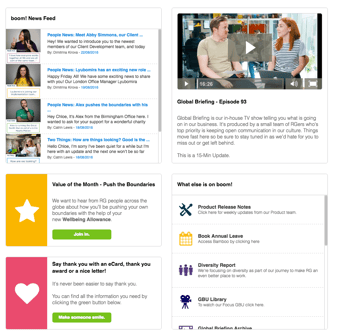
6 min read
I recently returned from a year off having had our first baby in July last year. Speaking to friends and family who have been in a similar situation, I started to realise that Reward Gateway did a really great job of keeping me engaged throughout the whole experience.
By doing this, as an organisation they welcomed back an excited and keen employee to the workforce, something I’m sure you’ll agree is incredibly valuable.
By talking with others, I also realised that what I experienced wasn’t the norm.
Many of my peers said they felt disconnected, disengaged and completely lost on their first day back. I started to wonder why others had such a different experience.
So as an employer, why does that matter, and what can you do?
Keeping connected to long-term leavers is critical. Accept that, and the rest will follow.
When your staff take time out from the business for a long period of time, whether it’s on sick leave, for a sabbatical or for parental leave, you have an enormous opportunity to keep them engaged. Those who don’t seize that opportunity risk people re-joining the organisation not wanting to perform in their role and in some cases not wanting to work at all.
In my experience, becoming a parent for the first time changes your whole perspective on work (and pretty much everything!). I’m fairly sure that the same can happen when you grow your family in any way, have time off on long term sick leave or take a significant break from work for whatever reason. The risk of feeling disconnected is enormous and employers can really help with that. Reward Gateway gives up to a year off of paid parental leave for the primary caregiver, and I took it. Here’s what got me through the year and the advice I give to you, the employer:

1. Keep in contact, but don’t demand a response straightaway
Reaching out to your staff is a must, whether it’s a casual ‘how are you doing’ email, providing them with key info (see point 2 below) or asking for their input on something, if that was discussed prior to the leave. For me, I wanted to be involved, but others may want to be entirely hands off during their leave. You need to have a clear conversation with your employees on what “involved” means — and stick to that! I really valued the emails and messages I received throughout my year off, it reminded me that there were other things going on in the world except for nappies, milk and feeling tired!
When you make the right kind of contact with your staff on leave, you lessen the risk they feel forgotten or excluded. Don’t forget however, you might not be their No. 1 priority at that moment. Keeping it clear that their response is optional is the most important thing. The aim is not to put pressure on the employee or give them anything else to worry about, whether they are on parental or sick leave, or they’re taking time out to refresh or gain new experiences on a sabbatical.

2. Give them all the “boring” but important info they need — nicely!
I say “boring” only because there’s a need for some key information that the employee might not be excited to read straight away, but really needs to know when they’re ready. An example of this is when Reward Gateway initiated a clear and simple letter to explain to those on parental leave everything they need to know. Whatever the type of leave, this should include things like;
- Important dates like when the employee is due to return, when their leave started etc
- Pay information
- Certificates or documentation the employer needs
- How their pension and other benefits will be affected
- If there is any impact on annual leave
- Who to contact with any questions or issues.
Include all the information the employee will need and make it absolutely crystal clear and friendly. You may as well write nothing rather than use cold language or information that will confuse the employee. If you already have this kind of letter, why not revisit it and ask: Would I understand this if I wasn’t in HR? Does it sound compassionate and friendly? Does it cover all the FAQs you’re likely to get? Better yet, take it to those who have experienced the kind of leave you’re writing for, and get their opinions.

3. Make sure the employee has access to your communication touchpoints and social media
Consider all the ways you communicate with your workforce who aren’t on leave. Some of the ways we reach our staff includes our benefits and communications Hub boom!, Facebook, Instagram, internal boom! TV, quarterly business update and the odd all-staff email.
As someone on parental leave, I had access and was invited to participate in all of these. There was no pressure to attend events or contribute, but my continued access to email and boom! plus small details like being tagged on social media when my son was born, meant I felt included throughout my time off. Practically speaking, an all-in-one engagement platform can help connect your staff, even when they’re not in the office.

4. Be genuinely welcoming when they return
This is about the lead up to, during and after the employee’s return to work. There’s no point making all this effort to communicate from the start of their leave if they’re not the least bit excited to come back or made to feel like one of the team again straightaway once they return.
I was given flexibility to plan when I was able to come back in for my “keeping in touch” (KIT) days and I had a mixture of catch up meetings, delivering training and performing other parts of my role. That’s what suited me and my team, and that’s the key balance; something that supports the employee and the team at the same time. You might need staff in a KIT scenario to perform back to work training, or sit in on key meetings or it might just be to get them familiar with a new or changed team, just try and involve the employee as much as possible when planning these days.
This might seem like a lot, but it’s necessary to keep valued employees feeling, well, valuable. The more you do, the more you’ll find your returning staff get back into the flow of work and your company culture. I know that every organisation will need to tailor their approach, as with any employee engagement tactic, but consider these starting points, from someone who’s been there!
Wondering what to do when your employee actually comes back? Stay tuned for my next post!

 Sarah Akanbi
Sarah Akanbi



